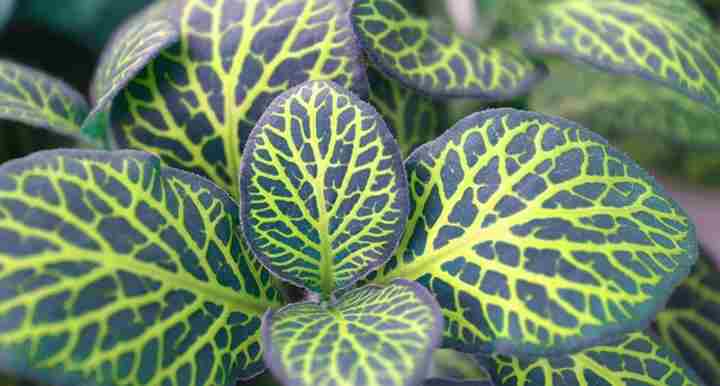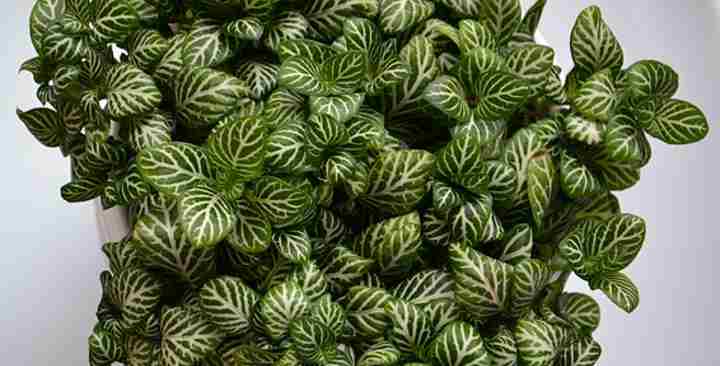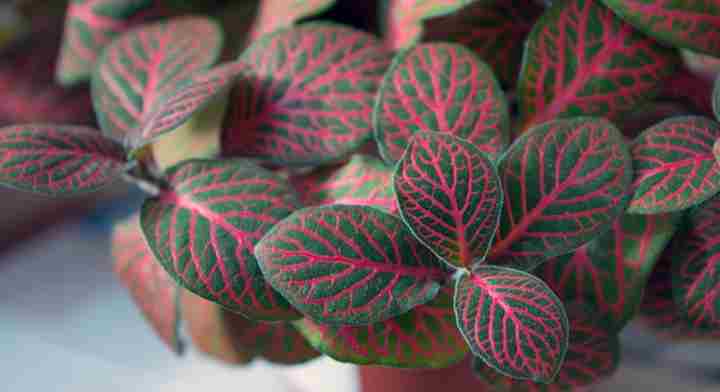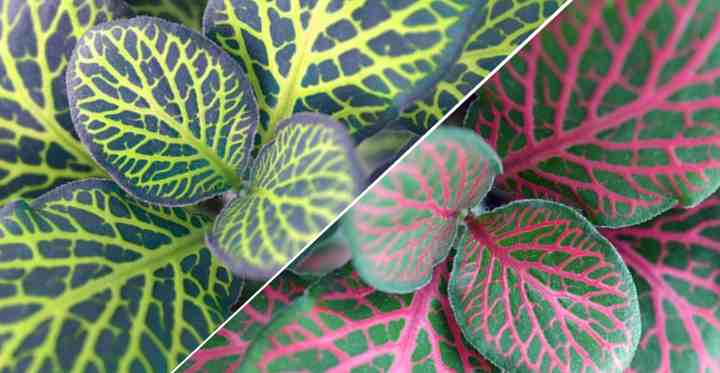Fittonia plants have patterned leaves with pink, red, pale green, or white veins and make stunning tropical houseplants. On the dark green leaves, these colorful patterns contrast well. Fittonias are also known as nerve plants, vein plants, mosaic plants, and painted net plants due to the complex veined patterning. Nerve plants are popular because they are simple to maintain at home and aid to brighten up any area.
Fittonia plants belong to the tropical plant family Acanthaceae and have the scientific name Fittonia albivenis. Native to the rainforests of South America, these flowering tropical plants Fittonias belong to the same botanical family as polka dot plants and all types of fittonias. Nerve plants are ideal for the home setting and thrive at ambient temperature.
How to care for nerve plant: The fittonia plant thrives in a temperature range of 60 to 80°F (16 to 26°C), with moderate light and ample humidity, in well-draining moist potting soil with plenty of organic content. Throughout the spring and summer, feed your nerve plants once a month or every other month. Broad leaves with vivid red veins characterize some types of fittonia plants, such as the Juanita nerve plant. Smaller leaves with white or pinkish-red veins are seen in nerve plant cultivars such as the ‘Red Anne’ or ‘White Anne’.
The miniature superba, pink angel, and purple vein nerve plant are other popular nerve plant cultivars. Some kinds of nerve plants have mosaic designs that almost make the dark green leaves bright red or white. In containers on your windowsill, hanging baskets, or terrariums, Fittonia plants have great ornamental value. You may also raise nerve plants outside in warmer regions. You’ll learn how to keep nerve plants healthy and disease-free in this article.
Nerve Plant (Fittonia) Care Summary

Nerve plants need well-draining soil and prefer indirect or partial sunlight. A temperature range of 60 to 80°F (16 to 26°C) is the optimum environment for healthy development. To keep the leaves vibrant and healthy, nerve plants need high humidity and indirect light.
Light and moisture are the two most important things to consider when caring for a nerve plant. Species of Fittonia albivenis need high humidity and moist soil, which is why they grow in tropical rainforest environments. Misting the veined leaves on a regular basis may help to raise the humidity.
How to Care for Nerve Plants
Let’s look at how to care for ornamental fittonia houseplants in greater depth.
Lighting Requirements for Nerve Plants

Fittonia nerve plants prefer to grow in low to medium sunlight conditions, so place them away from direct light. Nerve plants thrive in the wild on the ground in rainforests, where there is little light. A north-facing windowsill, behind sheer drapery, or in a bright nook away from direct rays are the greatest locations for growing vein plants.
If the leaves of your nerve plant show signs of burning, it’s a indication your nerve plant is getting too much sun. Therefore, if your nerve plant’s leaves have brown patches, are crispy, or begin to wilt, move it to a place where it receives less sunlight.
Nerve Plant (Mosaic Plant) Soil Requirements

To keep your nerve plant healthy, it should be in well-draining, moist soil. Vein plants prefer moist soil. The tropical environment in which mosaic plants flourish is comparable to this kind of soil. Ensuring that the soil is rich in organic matter is the ideal way to obtain the greatest soil for a nerve plant.
This is a watering combination that keeps enough moisture in the soil but does not get soggy. Fittingonias prefer peat-based soil or loamy potting soil as suitable soil types. Water should be able to drain out at the bottom of your nerve plant container. While it comes to watering your nerve plant, this is an important growing need.
How to Water Your Nerve Plant (Fittonia)

If nerve plants are to survive indoors, they must be watered excessively. Root rot may result. When caring for nerve plants, allowing the soil to dry out is the most common mistake. How can you determine when it is the best time to water your fittonia? When the top layer of soil is just dry, is the ideal time to water your vein plant. Water it sufficiently so that the container’s bottom begins to drain. Remember that the drying speed of the soil will be influenced by room temperature.
You may thus have to water your fittonia every other day if your room is warm. It’s also important to understand that excess moisture may cause root rot. So, don’t let your fittonia get wet. Also avoid putting your pot in a water-filled saucer. Using water that is at room temperature is another care tip for nerve plants.
By watering your delicate houseplant with tepid water, you avoid shock to the plant. If the leaves of your fittonia wilt and turn yellow, it’s a surefire sign that you’re overwatering it. Repotting your nerve plant and cutting off any damaged roots is the best fittonia plant care advice. Make sure that the soil is only ever wet, not excessively dry or soggy, to avoid leaf damage or weak plant development.
Proper Humidity for Nerve Plant Care

Nerve plants need a lot of humidity since they are a native rainforest plant. The best way to increase humidity in the home is to mist the plant. The pink, red, or white veins will stay vivid and the leaves will stay dark green because of high moisture levels. When the leaves of your nerve plant begin to droop is one indication of whether it is humid. Your tropical house plant will usually be revived by misting the leaves.
Using a humidifier is another technique to ensure that your tropical nerve plant receives enough humidity. If you have a lot of tropical houseplants to care for, this technique is extremely helpful. When the family heat dries the air in the winter, humidifiers are also beneficial. Yet, to look after nerve plants, you don’t have to spend a lot of money on a humidifier.
Setting your vein plant on a pebble tray filled with water is a simple way to create a humid environment for it. Just be sure to check that the soil does not absorb water when you are done. Your nerve plant will thrive in beautiful leaves and beautifully patterned leaves if you create the proper atmosphere for it in terrariums.
Nerve Plant (Fittonia) Temperature

The right temperature is required for all types of nerve plants, such as Juanita, Red Anne, White Brocade, and other fittonia cultivars. Thankfully, you don’t have to make your house uncomfortable by making it hot and humid. typical room temperatures are ideal for nerve plants. Your fittonia plants should be kept between 60 and 80°F (16 and 26°C) throughout the year. In order for your nerve plants to grow at an even temperature, keep them out of direct sunlight in shady conditions.
Fittonias should be kept out of cold drafts, according to another care tip. The leaves of the houseplant may begin to fall if the temperature drops too low. Move your plant to a warmer area if this happens. However, since it might dry out the soil and your vein plant might begin to wilt rapidly, do not place it next to a heater.
Nerve Plant Feeding Requirements
You’ll need to fertilize your fittonia plant from time to time in order to care for it properly. Your indoor plants will thrive with a regular houseplant fertilizer. Throughout the spring and summer, feed your vein nerve plants once a month or every other. Since development is barely sufficient in late autumn and winter, you may stop giving your plant.
Mineral salts buildup can harm your plants, as it does with many houseplants. Flush the soil with water every time you feed to prevent this. Leaf burn is one indication that you are giving your nerve plant too much food. Water the plant thoroughly and allow all of the excess water to drain if you notice brown patches on the mosaic or veined leaves. The accumulation of salts can be reduced by flushing the soil.
Mosaic Plant (Nerve Plant) Pruning
Regularly trimming your mosaic plant helps to maintain a bushier, more lush look while caring for healthy growth. Pinching off the ends of growing stems is the most essential pruning tip for fittonias. This method of trimming helps avoid leggyness and gives your homeplant a fresh look.
Others recommend that flower spikes be removed. Despite the fact that nerve plants bear flowers, their dark green leaves with colorful veins are far more noteworthy than the flowers. Floral pinching helps to focus development in the lush greenery. You may, of course, let your nerve plant bloom if you like.
Nerve Plant (Fittonia) Repotting
Repotting your nerve plant every one to two years will also help it thrive. All of these steps help your fittonia to thrive when the soil is replaced, roots are trimmed back, or it is repotted. Re-potting your nerve plant is for two reasons. Pruning the roots is one way to limit development. The second option is to put your fittonia in a bigger container, which will help it grow.
You may want to repot your fittonia every year if you’re growing it in a terrarium. Remove the plant from the pot and discard any excess soil before gently removing it. By roughly 1.5″ to 2.5″ (4 cm), you can prune back roots. Repot your nerve plant in its tiny container using organic-rich potting soil.
When repotting small nerve plants, avoid trimming back the roots if you want them to grow larger. Select a bigger container than the current one. Your new pot should have a drainage hole on the bottom, and ensure that the plant’s soil is well-draining. To make water flow more effectively through the soil, you might also add a layer of clay pebbles at the bottom.
Varieties of Nerve Plants (Fittonia)

There are a variety of white Anne nerve plants to choose from in the photograph. The leaves of all fittonia cultivars are glossy and lush. However, the diverse red, pink, light green, and white hues are distinguished by their intricate vein patterns. The ovate shape of nerve plant leaves gives them a pointed end. Longer tips are seen on certain kinds of nerve plants, whereas lanceolate-shaped leaves are seen on others.
Nerve plant types are usually divided into two categories. The Argyroneura group contains leafy plants with white veins, while the Verschaffeltii group contains red or pink veined plants. The following are some of the most well-known nerve plants.
- White Anne nerve plants Dark green leaves with prominent white-veined patterns.
- Juanita vein plant Fittonia cultivar features huge leaves and bold crimson patterns that run throughout the leaves.
- Pink Angel nerve plant Bright pink and green leafy foliage makes a showy yet compact fittonia. It adds a little bit of color to any space, and it’s just perfect.
- Black Star and Pink Star nerve plants Wavy leaves with prominent veins traceong the leaf surface have been observed. The plant has a dark appearance because of the Black Star fittonia’s thread-like patterns that are reddish-purple.
- Frankie fittonia plants These are lovely pink houseplants that you can grow. The leaves look pure pink with green edging due to the dense pink vein patterns.
- Superba nerve plants. The vein patterns are clearly visible, and the veins are a clean white color. These fittonia cultivars feature huge, spectacular leaves. These nerve plants may grow up to 8 inches (20 cm) tall.
Just 3 to 6 inches (7.5 to 15 cm) tall, tiny little miniature fittonia plants Nerve (vein) plants of larger varieties may reach a height of 12 to 18 inches (30 to 45 cm).
Nerve Plant, Mosaic Plant, Juanita Plant Flowers

Fittonia is a genus of tropical flowering plants with lovely leaves rather than beautiful flowers as the star feature. Your fittonia will bloom with little flowers if the right growing conditions are met. What do nerve plant blooms look like? On tiny spikes, the tiny flowers bloom. White or light pink blooms are possible.
It may be tough to detect the little flowers since nerve plant leaves are also green and pink. Most individuals pinch off the flower spikes of a nerve plant as soon as they appear. Pruning the blossoms helps concentrate all of the nutrients on the variegated leaves, as well as promoting good leaf development.
Are Nerve Plants Toxic?
There isn’t a number for that. Pets and people are not harmed by nerve plants.
Nerve Plant Propagation
The fact that nerve plants are simple to propagate is one of the great things about having them as house plants. If you want to expand your collection of tropical houseplants, all you need is a few cuttings. Propagating your lovely fittonia plants in the spring or early summer, when they’re growing fastest, is the best time. Cut the stems of nerve plant cuttings down to at least two nodes to encourage cutting.
The places where the leaves are attached to the stem are called nodes. Lower leaves should be removed. You can put cuttings in water or put them straight into moist potting soil once you have them. They’ll start producing roots after around 2 or 3 weeks, if you’ve observed it.
Nerve Plant Pests and Diseases
Nerve plants are generally free of diseases and insects. They’re tough houseplants that grow well in moist soil in typical indoor temperatures. Misting the leaves on a regular basis helps to ensure that the nerve plant is healthy. Mealy bugs, aphids, and thrips are some of the pests that can harm nerve plants.
It’s preferable to isolate your fittonia plant from other plants in order to prevent the mites from spreading. If you notice any around your plant, it’s best to do so.
Your nerve plant might appear to be dying for a variety of reasons. The plant’s growing environment is frequently to blame for wilting leaves, brown leaf spots, or shriveled leaves. Make sure the soil isn’t soggy or dry, and that your plant isn’t in direct sunlight.
